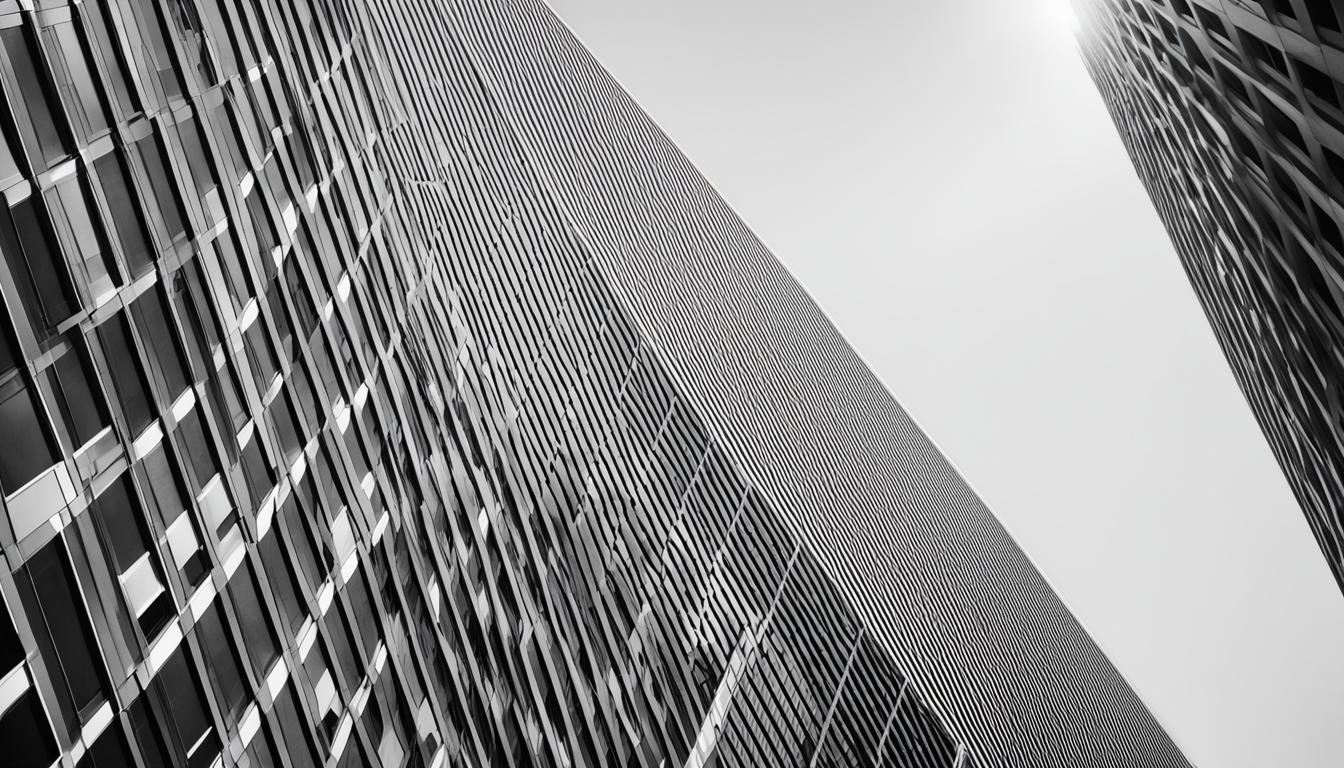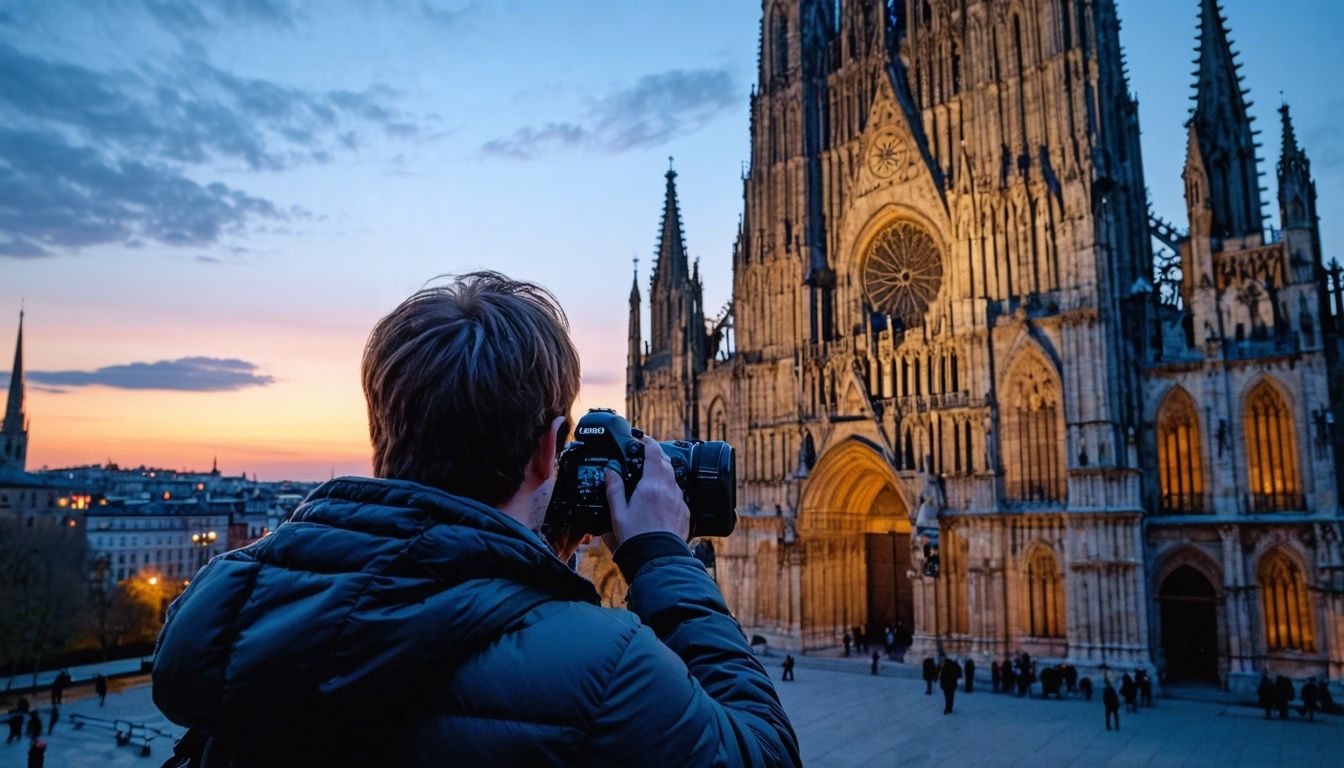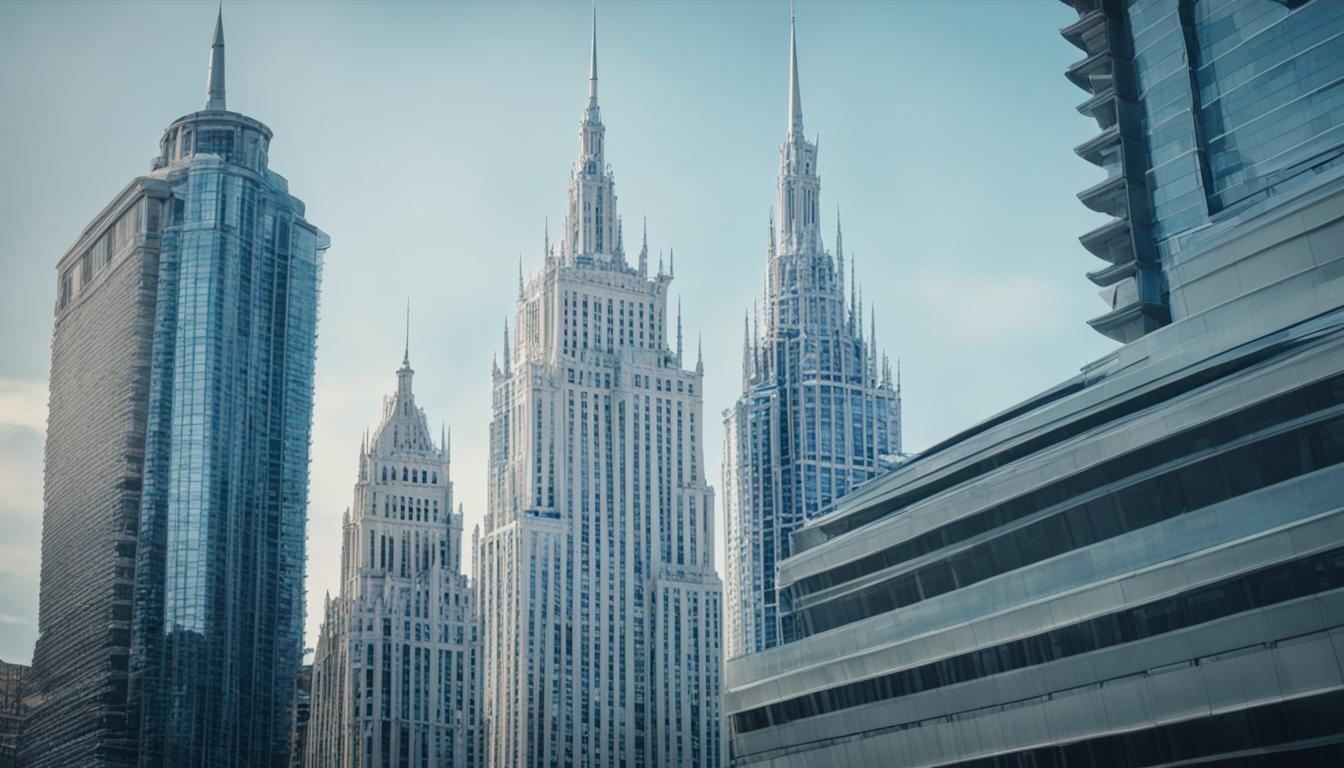Welcome to our guide on exploring the elegance of black and white architectural photography. In this article, we will delve into the artistry of capturing stunning black and white images that showcase the beauty and intricate details of architectural designs. By utilizing monochrome photography, we can create timeless and visually captivating compositions that highlight the shapes, textures, and contrasts of buildings.
Key Takeaways:
- Black and white architectural photography adds a timeless and elegant touch to images, showcasing shapes, textures, and contrasts.
- Choosing the right subject is crucial, focusing on buildings with strong geometric forms, interesting patterns, or striking details.
- Camera settings and techniques, such as shooting in RAW format and using filters, enhance the quality of black and white images.
- Mastering light and exposure plays a significant role in capturing the mood and atmosphere of architectural photos.
- Post-processing and editing techniques allow for the fine-tuning and enhancement of black and white images, bringing out the artist’s vision.
Choosing the Perfect Subject
Not every building will look good in black and white, so it’s important to carefully choose the subject. Buildings with strong geometric forms, interesting patterns, and striking details can create visual interest without relying on colors. Avoid plain or cluttered buildings and those that blend too much with the background. Experimenting with different angles and perspectives can enhance the impact of the subject. Environmental conditions like weather and time of day also play a role in adding depth and interest to architectural photography.
When it comes to black and white architectural photography, selecting the right subject is key to capturing captivating images that stand out. Architectural subjects with visually appealing features such as geometric forms, interesting patterns, and striking details can create a strong visual impact even without the use of vibrant colors.
Avoid photographing plain or cluttered buildings that may not offer enough visual interest in black and white. Look for structures with unique architectural designs and distinct features that can be highlighted by the absence of color.
Experimenting with different angles and perspectives can also enhance the overall composition of the photograph and emphasize the subject’s key elements. By exploring various viewpoints, you can discover new angles that reveal hidden patterns, shapes, and textures within the architecture.
Additionally, consider the environmental conditions when selecting your subject. The interplay of light and shadow, as well as the mood created by the weather or the time of day, can add depth and interest to your black and white architectural photographs.
By carefully choosing subjects with strong geometric forms, interesting patterns, and striking details, you can capture visually compelling black and white architectural images that evoke a sense of timeless beauty and visual interest.
Camera Settings and Techniques
When it comes to black and white photography, getting the right camera settings is essential for capturing stunning architectural photos. Let’s explore some key techniques and settings that can elevate your black and white images to the next level.
Shooting in RAW
To maximize flexibility and control during the editing process, shooting in RAW format is highly recommended. RAW files contain a wealth of information, allowing you to make precise adjustments to exposure, contrast, and white balance without sacrificing image quality. This is particularly important in black and white photography, where subtle tonal variations can greatly enhance the final result.
Adjusting ISO
When shooting in low light conditions, it may be necessary to increase the ISO to maintain proper exposure. However, high ISO settings can introduce unwanted noise and grain into your images, which can be more pronounced in black and white. To minimize these effects, it’s best to use the lowest ISO value possible, such as 100 or 200, while still achieving the desired exposure.
Utilizing a Polarizing Filter
A polarizing filter is a valuable tool for black and white architectural photography. It helps to reduce glare and unwanted reflections, resulting in increased contrast and richer, deeper tones. By selectively filtering light, a polarizing filter can bring out the textures and details of buildings, adding depth and visual interest to your images.
Monochrome Mode and Picture Styles
Most digital cameras offer a dedicated monochrome mode or picture style, allowing you to preview your images in black and white directly on the LCD screen. By shooting in monochrome mode, you can better visualize the final result and make necessary adjustments to composition and exposure. Alternatively, you can apply a monochrome picture style in post-processing to convert your color images to black and white.
In combination with the right camera settings, these techniques can help you capture breathtaking black and white architectural photos. Let’s take a moment to appreciate the power of these techniques in the example below:

| Camera Setting | Example Value | Explanation |
|---|---|---|
| File Format | RAW | Allows for maximum flexibility and control during editing |
| ISO | 100 | Minimizes noise and grain in black and white images |
| Filter | Polarizing | Reduces glare and reflections, increases contrast |
| Picture Style | Monochrome | Enables previewing the image in black and white on the LCD screen |
By adjusting camera settings such as shooting in RAW, optimizing ISO, utilizing a polarizing filter, and utilizing monochrome mode or picture styles, you can unlock the full potential of black and white architectural photography. These techniques allow you to capture the intricate details, textures, and tonalities of buildings, producing captivating images that stand the test of time.
Mastering Light and Exposure
When it comes to black and white photography, understanding light and exposure is fundamental. Capturing the right balance of tones is crucial to create impactful and visually appealing images. In this section, we will explore the importance of exposure and how light can enhance the mood and atmosphere of your black and white architectural photographs.
One essential tool for achieving proper exposure is the histogram. It provides a visual representation of the tonal range in your image, helping you ensure that the highlights and shadows are not clipped. By using the histogram, you can make adjustments during shooting to maintain balanced tones and retain important details in both bright and dark areas.
When photographing in black and white, it is important to expose for the midtones. This ensures that your image has a good range of tonal values, with sufficient detail in the middle shades. Avoiding overexposure or underexposure is crucial to maintain the desired aesthetic and prevent loss of details.
“Light makes photography. Embrace light. Admire it. Love it. But above all, know light. Know it for all you are worth, and you will know the key to photography.” – George Eastman
Light is a powerful element in photography, and it plays a significant role in black and white architectural photography as well. Different types of light, whether it be natural or artificial, can create various effects and enhance the mood of your images. Here are a few lighting techniques to consider:
Backlighting:
Positioning your subject in front of a light source can create a dramatic effect, with silhouettes and strong contrasts. Backlit subjects can reveal interesting shapes and outlines, adding depth and dimension to your architectural photographs.
Sidelighting:
Sidelighting is when the light falls on the subject from one side, emphasizing the texture and surface details. It can bring out the dimensionality of buildings, enhancing the sense of depth and highlighting architectural features.
Frontlighting:
Frontlighting is when the light source is behind you, illuminating the subject directly. It provides even lighting across the building, allowing you to capture intricate details and textures. This technique works well for showcasing architectural designs with intricate patterns or unique surfaces.
By combining your knowledge of exposure and utilizing different light sources, you can create stunning black and white architectural photographs that capture the essence and beauty of the buildings.
Next, we will explore the post-processing and editing techniques that will elevate your black and white architectural images to the next level.
Post-Processing and Editing
Post-processing and editing are crucial steps in black and white photography. They allow us to fine-tune and enhance our images, bringing out their full potential. Let’s explore some techniques, software tools, and adjustments that can take our black and white architectural photography to the next level.
Software Tools for Editing
When it comes to post-processing black and white photos, we have a variety of software tools at our disposal. Some popular options include:
- Adobe Photoshop
- Adobe Lightroom
- Silver Efex Pro
These tools offer a range of features and capabilities for adjusting and enhancing black and white images. Whether you prefer Photoshop’s extensive editing options, Lightroom’s streamlined workflow, or Silver Efex Pro’s dedicated black and white editing tools, you’ll find powerful software to suit your needs.
Basic Adjustments
Before diving into advanced editing techniques, it’s important to master the basics. Here are a few fundamental adjustments for black and white photography:
- Cropping: Use cropping to enhance composition and remove any distracting elements.
- Straightening: Ensure that your horizons are level and vertical lines in your architecture are straight.
- Sharpening: Apply sharpening to enhance the details and make your images look crisp.
- Noise reduction: Reduce noise or grain in your images for smoother, cleaner results.
Advanced Editing Techniques
For more creative control over your black and white architectural photos, consider using advanced editing techniques. These include:
- Tonal contrast: Adjusting the contrast between different tonal ranges to add depth and dimension.
- Curves and levels: Fine-tune the overall tonal balance of your image by adjusting curves and levels.
- Dodge and burn: Lighten or darken specific areas of your image to emphasize or de-emphasize certain elements.
- Selective color: Introduce subtle touches of color in your black and white photos for added impact.
Filters, Presets, and Effects
To achieve different styles and moods in your black and white architectural photography, consider applying filters, presets, or effects. These can help you achieve effects such as a vintage look or a sepia tone. Experiment with different options to find the style that best suits your vision and enhances the mood of your images.

Through post-processing and editing, we can transform our black and white architectural photos into captivating works of art. The possibilities are endless, allowing us to express our artistic vision and create images that leave a lasting impression.
Embracing the Beauty of Black and White Architecture
Black and white architectural photography captivates with its timeless grace and elegant aesthetic. It offers a unique perspective that allows us to appreciate the essence and beauty of buildings in a whole new way. Through the skillful interplay of subject selection, camera settings, understanding of light, and post-processing techniques, photographers can create stunning black and white images that showcase the shapes, forms, textures, and contrasts of architectural designs.
By embracing the beauty of black and white, we can capture monochromatic landscapes that evoke a sense of tranquility and simplicity. The absence of color compels the viewer to focus on the intricate details and exquisite lines of the buildings, inviting us to explore the artistic vision behind each structure. Black and white architectural photography allows us to appreciate the interplay of light and shadow, revealing the depth and character of architectural designs.
With each frame, we have the opportunity to tell a story through our lens. The artistic vision of black and white architectural photography allows us to create images that transcend time, capturing the essence of a moment and preserving it for eternity. These images possess a timeless quality that enables viewers to connect with the architecture on a deeper, more emotional level.
Through careful selection of subjects, mastery of camera settings, understanding of light, and skillful post-processing, we can create black and white architectural photographs that exude an air of sophistication and celebrate the artistry of architecture. So let us seize the power of black and white and embark on a journey to capture the captivating beauty and timeless allure of architectural designs.
FAQ
What is black and white architectural photography?
Black and white architectural photography is a technique that involves capturing images of buildings and architectural structures in monochrome, devoid of color. This style of photography emphasizes shapes, textures, and contrasts, creating a timeless and elegant aesthetic.
How do I choose the perfect subject for black and white architectural photography?
When choosing a subject for black and white architectural photography, look for buildings with strong geometric forms, interesting patterns, and striking details. Avoid plain or cluttered buildings and those that blend too much with the background. Experimenting with different angles and perspectives can also enhance the impact of the subject.
What camera settings and techniques should I use in black and white architectural photography?
To capture high-quality black and white architectural photos, consider shooting in RAW format for more flexibility in post-processing. Adjust your ISO to a low value, such as 100 or 200, to minimize noise. Using a polarizing filter can reduce glare and reflections while increasing contrast. You can also set your camera to black and white mode or use a monochrome picture style to preview the image in black and white on the LCD screen.
How can I master light and exposure in black and white architectural photography?
Understanding exposure is crucial in black and white photography. Use the histogram on your camera to ensure a balanced distribution of tones, avoiding clipped highlights or shadows. Consider the different types of light, both natural and artificial, to create varying effects. Backlighting, sidelighting, and frontlighting can emphasize the shape, texture, or detail of the building.
What post-processing and editing techniques can I use for black and white architectural photography?
Post-processing and editing are essential steps in black and white photography. Software tools like Photoshop, Lightroom, and Silver Efex Pro can help fine-tune and enhance your images. Basic adjustments like cropping, straightening, sharpening, and noise reduction can improve the overall quality. More advanced adjustments like tonal contrast, curves, levels, dodge and burn, and selective color allow for creative control. Applying filters, presets, or effects can also help achieve different styles and moods.
Why should I embrace the beauty of black and white architecture?
Black and white architectural photography offers a timeless and elegant aesthetic that highlights the beauty and essence of buildings. By capturing monochromatic landscapes, you can evoke a sense of grace and create a striking visual impact. Embracing black and white allows for the artist’s vision to shine, celebrating the artistry of architecture.
How does Lighting Play a Role in Achieving Elegance in Black and White Architectural Photography?
In black and white architectural photography, the importance of lighting techniques cannot be overstated. The play of light and shadow accentuates the elegant lines and textures, adding depth and dimension to the composition. Careful use of lighting can transform a simple building into a timeless work of art.




